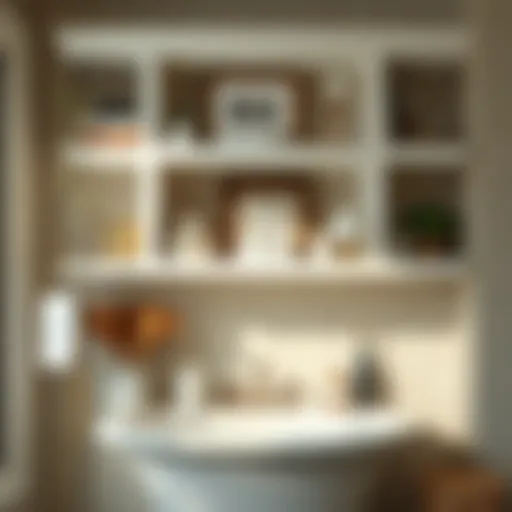Quartz Countertops for Bathroom Vanities Guide
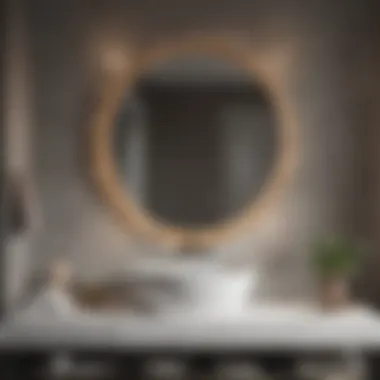

Intro
Quartz countertops have gained immense popularity in recent years, especially for bathroom vanities. This trend is not just a mere coincidence. Homeowners are increasingly attracted to quartz due to its aesthetic appeal and functional advantages. As a manufactured stone, quartz combines natural stone with resins, providing a unique blend of beauty and durability.
In bathroom design, vanities often serve as a centerpiece. Choosing the right material for a vanity can elevate the overall ambiance. Quartz countertops offer a range of colors and patterns, making it easier to complement various styles and themes. This article looks closely at the merits of quartz, digging into trends, color options, and maintenance requirements.
By examining quartz in detail, this guide aims to equip readers with information necessary to make informed decisions for their home. Knowing what works and what doesn’t can make a significant impact on the bathing experience and aesthetics of the entire bathroom.
Trending Styles
When it comes to designing a bathroom, style plays an important role. Quartz countertops can seamlessly fit into various decor styles.
Modern Minimalism
The modern minimalist approach focuses on simplicity and functionality. Here, quartz countertops often feature clean lines and subtle textures. Shades such as white, gray, and black dominate this style, emphasizing the beauty of simplicity. Glossy finishes may be used to enhance the sense of space and light.
Some advantages of choosing quartz for modern minimalism include:
- Durability: Resistant to chips and scratches.
- Non-porous: Prevents bacteria growth, making it a healthy choice.
- Ease of maintenance: Requires less upkeep compared to natural stone options.
Cozy Rustic
Conversely, the cozy rustic style embraces warmth and earthiness. Here, quartz can mimic the appearance of natural stones, like slate or sandstone. The tones are typically warmer, often ranging from deep browns to sandy beiges. Textured finishes can also introduce depth to the design.
Reasons to consider quartz in a rustic design:
- Versatility: Can be crafted to match various rustic elements such as wood and metal.
- Weather-resistant: Suitable for bathrooms with variable humidity levels.
- Wide variety: Numerous styles available, from speckled to veined patterns.
"The choice of countertop material can drastically influence how a bathroom feels. Quartz offers both beauty and practicality, to suit any design scheme."
Color Palettes
Selecting a color palette is crucial for the atmosphere in a bathroom. Quartz countertops offer diverse color options, making it easier to match or contrast with bathroom elements.
Calming Neutrals
Neutrals like soft gray, creamy white, and muted beige provide a serene backdrop. These colors work well with various fixtures and hardware, facilitating harmonious combinations. This palette is particularly appealing for those looking to create a spa-like retreat.
Bold Accents
For those who wish to make a statement, bold accent colors like deep navy or emerald green can add a dramatic flair. Pairing these with lighter cabinetry can create a striking contrast. This approach can transform a bathroom into a vibrant space, allowing for self-expression through design choices.
Foreword to Quartz Countertops
Quartz countertops have gained significant popularity in recent years, particularly for bathroom vanities. This section underscores the importance of quartz as a material, exploring its qualities and the evolution of its use in modern design. Homeowners and designers alike are increasingly drawn to quartz due to its combination of aesthetic appeal and functional benefits.
Understanding Quartz as a Material
Quartz is an engineered stone made from about 90% crushed natural quartz crystals combined with resins and pigments. This composition gives quartz countertops their unique characteristics. Unlike natural stones, quartz countertops are non-porous and do not require sealing. This is a major advantage as it helps prevent bacteria buildup, making it a safe choice for bathroom environments. In addition, quartz provides a vast array of colors and patterns, meaning it can fit seamlessly into any design aesthetic.
One of the notable features of quartz is its durability. It can withstand daily wear and tear, making it suitable for busy households. As a housewife or homeowner, opting for quartz might mean fewer worries about chips or scratches, especially in a bustling bathroom. Moreover, the low maintenance requirement of quartz, cleaning involves simply using warm soapy water, adds to its appeal. This material stands out in its resilience and ease of upkeep.
The Evolution of Quartz Countertops
Historically, natural stones like granite and marble were the go-to options for countertops. However, the rise in demand for durable and low-maintenance materials has shifted perspectives. The introduction of engineered quartz began in the late 20th century. What's crucial to note is the enhancement in technology that has contributed to quartz's rise. Advances in production techniques have not only improved strength but also diversified the design options available.
Today, quartz countertops come in a variety of styles, imitating the look of natural stones while offering superior durability. This evolution has been marked by a transition towards environmentally friendly practices in quartz production, which resonates with today’s eco-conscious consumers.
Advantages of Quartz Countertops
Selecting the right material for bathroom vanities is a pivotal aspect of home design. One compelling choice is quartz countertops. They offer a combination of aesthetic appeal and practical benefits that resonate with many homeowners. Understanding these advantages can empower you to make informed decisions that enhance the elegance and functionality of your space.
Durability in Bathroom Settings
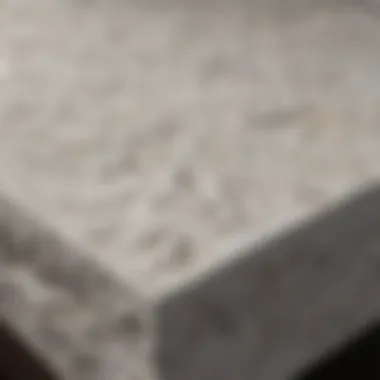

Quartz countertops exhibit exceptional durability. They are engineered stone, composed of approximately 90% crushed natural quartz and polymers. This unique composition allows quartz to withstand the rigors of a busy bathroom environment. Unlike natural stones, quartz does not chip or crack easily. The surface is rather resilient, making it ideal for areas where heavy objects may fall.
Moreover, bathrooms often encounter moisture. Traditional materials may warp or degrade over time. Quartz, by contrast, is non-porous, which means it resists water absorption. This feature helps in preventing bacterial growth. A durable surface translates to fewer repairs and replacements, making it a sound investment.
Resistance to Stains and Scratches
The resistance of quartz countertops to stains and scratches is another significant advantage. Because of its non-porous nature, quartz does not easily absorb liquids. Thus, substances like makeup, oils, or cleaning agents do not stain it, which is a crucial factor for bathroom vanities.
In comparison to materials like marble or granite, quartz is less prone to scratches. The engineered process used to craft quartz surfaces ensures that they maintain a polished look over time. When installed properly, you can expect your countertop to repel everyday wear and tear effectively. This aspect of quartz not only preserves its aesthetic appeal but also minimizes the need for frequent refinishing.
Low Maintenance Requirements
Maintenance is an essential consideration in choosing countertops. Quartz countertops are renowned for their low maintenance needs. Unlike natural stones that may require sealing to maintain their integrity, quartz doesn’t need such treatments. Wiping down the surface with mild soap and water will suffice for regular cleaning.
In addition, quartz’s stain resistance simplifies maintenance routines. It is less likely to lose its sheen from spills or daily use. Homeowners can appreciate spending less time on upkeep and more on the enjoyment of their space. Therefore, quartz countertops present a blend of luxury and practicality, making them a favorable option for today’s modern bathrooms.
"Choosing quartz means embracing a material that combines high durability with minimal maintenance, enhancing the bathroom experience for homeowners."
Design Considerations for Bathroom Vanities
Choosing the right design for bathroom vanities is crucial for achieving an aesthetically pleasing and functional space. The right countertop can significantly influence both the look and usage of the vanity. This section will explore important factors that homeowners should consider when selecting quartz countertops for their bathrooms. Each aspect outlined below contributes to the overall ambiance and practicality of the design, ensuring that the final result aligns with the homeowner's vision and needs.
Color and Pattern Choices
The color and pattern of quartz countertops play a vital role in determining the overall mood of the bathroom. Homeowners should carefully consider the existing colors in the bathroom, including wall paint, tile, and fixtures. Light colors like whites and creams can make a small bathroom feel larger and more open, while darker shades can add depth and create a cozy atmosphere.
Patterns also vary widely in quartz options. Some may prefer a solid color for a sleek look, while others might opt for marble-like veining for elegance.
Popular choices in colors include:
- Soft whites
- Deep blacks
- Earthy tones
- Bright blues or greens for accents
These selections can be tailored to fit personal preferences while harmonizing with the overall design scheme, making it essential to sample potential options alongside other bathroom elements.
Textural Elements and Finishes
The texture and finish of a quartz countertop can impact both its appearance and functionality. Several finishes are available, including polished, honed, or leathered.
- Polished finishes provide a glossy shine that reflects light, perfect for creating a bright environment.
- Honed finishes offer more of a matte look, suitable for a contemporary style and often providing a more forgiving surface regarding scratches.
- Leathered finishes add depth and dimension, providing a more rugged yet sophisticated appearance.
These finishes also affect maintenance practices. For instance, a polished surface may resist stains easily, but can show water spots. In contrast, a honed surface could require more regular upkeep to maintain its look. Homeowners should weigh aesthetic preferences with practical considerations to arrive at a decision best for their needs.
Customization and Fabrication Options
Customization in the design of quartz countertops allows homeowners to achieve a unique look tailored to their specific spaces. Many suppliers offer fabrication services that can accommodate various sizes and shapes, ensuring that the countertop fits perfectly in the intended area.
Buyers can also make decisions about:
- Edge profiles: Common profiles include beveled, rounded, and straight edges. Each adds distinct character to the countertop.
- Sink integration: Seamless sink options can provide a cleaner appearance.
- Backsplashes: Coordinating the backsplash with the countertop can enhance the overall cohesion of the design.
Ultimately, the possibilities for customization can enhance the visual appeal and functionality of the vanity. Engaging with local fabricators may provide more insights into what options are available and best suit individual projects.
Investing time in the design phase is equally as important as deciding the material. Choosing the right elements will elevate the space.
Installation Process of Quartz Countertops
The installation process of quartz countertops is a critical stage in achieving the desired aesthetics and functionality for bathroom vanities. Proper installation can result in a visually appealing surface that also provides durability and ease of maintenance. There are several elements to consider, including preparation, the actual installation, and post-installation care. Each of these components plays a vital role in ensuring the longevity and performance of quartz countertops.
Preparation for Installation
Before the installation begins, thorough preparation is necessary. This phase includes measuring the vanity space accurately. It is essential to take precise measurements to avoid any misfit during installation, which can lead to frustrating adjustments later. Also, choosing the right style and color beforehand can streamline the process. The selected slab needs to be checked for any imperfections, as quartz can be heavy and fragile.
In addition, it is crucial to ensure the vanity surface is level. An uneven base can result in cracks or gaps when the countertop is fitted. This phase may require shimming or reinforcing the cabinetry to create a stable base. Lastly, having the right tools such as a circular saw, adhesive, and clamps is necessary to perform the job efficiently. If the homeowner is not confident in their DIY skills, hiring a professional installer is advisable.
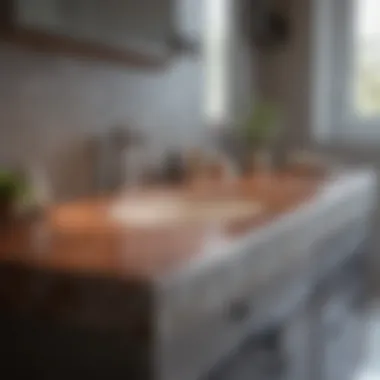

The Installation Procedure
The actual installation process involves several steps. First, the quartz slab is carefully placed on the vanity. Aligning the slab correctly with the edges of the cabinet is important to achieve a seamless look. Once positioned, a special adhesive is applied underneath, securing the countertop in place. During this step, it is essential to use clamps to hold the slab in the right position until the adhesive sets.
After the adhesive has dried, it's time for sealing. While quartz is non-porous and does not require traditional sealing, proper care needs to be taken to seal any seams between the countertops and the walls. This helps prevent moisture from seeping through, which is particularly important in a bathroom environment. In some cases, the installer might use a silicone-based sealant for additional protection.
"Proper installation ensures the durability and functionality of quartz countertops in bathroom vanities."
Post-Installation Care
Post-installation care is crucial for maintaining the beauty and longevity of quartz countertops. Once installation is complete, it is advisable to wait at least 24 hours before using the vanity. This allows the adhesives to set fully. During this time, the homeowner can clean the area, ensuring it is free from dust and debris.
Regular cleaning is easy; simply using a mild detergent and water is sufficient for routine upkeep. Homeowners should avoid using harsh chemicals or abrasive cleaners as they can damage the surface. It is also important to wipe up spills promptly to maintain the counter's pristine state.
In addition, periodic checks for any visible issues such as cracks or chips can help in addressing repairs early. With proper attention, quartz countertops can remain a beautiful and functional feature in any bathroom for many years.
Comparing Quartz with Other Countertop Materials
Comparing quartz with other countertop materials is essential for those considering a new bathroom vanity. Each material has unique characteristics that cater to different needs and preferences. By understanding these differences, homeowners can make informed decisions that align with their aesthetic and functional requirements. This section will analyze quartz in relation to granite, marble, and solid surface materials, focusing on performance, appearance, and maintenance.
Quartz vs. Granite
When comparing quartz with granite, several factors merit consideration. Both materials are popular choices for countertops, yet they differ significantly in composition and properties.
- Composition: Granite is a natural stone, while quartz is engineered. This distinction affects durability and aesthetics. Granite often features unique patterns, while quartz’s design can be more uniform and tailored.
- Durability: Quartz tends to be more durable than granite. Engineered quartz is non-porous, which means it repels stains and moisture better than granite, which can absorb liquids if not sealed properly.
- Maintenance: Granite requires regular sealing to prevent stains and bacterial growth. Quartz, on the other hand, offers a lower maintenance requirement. A simple wipe-down is usually sufficient for quartz.
Overall, homeowners may prefer quartz for its durability and easier upkeep, while others may choose granite for its natural beauty and uniqueness.
Quartz vs. Marble
Quartz and marble also present distinct differences that can influence a homeowner’s choice. Here are critical comparisons:
- Aesthetic Appeal: Marble is renowned for its elegance and variety of colors. It adds a timeless beauty that quartz can mimic but often lacks. While quartz can be customizable, it may not have the same luxurious feel.
- Durability: Quartz is more resilient than marble. Marble is softer and more prone to scratching and staining. For bathrooms that see frequent use, quartz may be the better option.
- Maintenance: Marble requires regular care, including sealing and specific cleaning methods. Quartz offers a more straightforward cleaning process, making it favorable for busy households.
Those desiring a classic and elegant look may lean towards marble, but for practical reasons, quartz is often the more sensible choice.
Quartz vs. Solid Surface Materials
Solid surface materials, like Corian, are yet another option for countertops. Here’s how quartz stands up against them:
- Design Flexibility: Solid surface materials allow for seamless installations, which can create an aesthetically pleasing look in some designs. Quartz, while not seamless, offers a wide variety of colors and patterns.
- Durability: Quartz is more durable than solid surfaces. It is less susceptible to scratches and heat damage, making it more suitable for high-traffic bathrooms.
- Maintenance: Solid surfaces can be more prone to staining and may require special cleaning products. Quartz’s non-porous surface means it resists staining and cleans easily.
In summary, solid surface materials can offer unique design elements, but quartz tends to provide superior durability and maintenance options.
"Choosing the right countertop material is not just a matter of aesthetics; it also involves practical considerations that can affect daily life."
In comparing quartz with granite, marble, and solid surfaces, it becomes clear that quartz offers a blend of beauty and practicality making it a strong contender for bathroom vanities. With a focus on durability and low maintenance, quartz can serve the needs of homeowners looking for both functionality and elegance.
Environmental Impact of Quartz Countertops
The increasing awareness of environmental issues leads many homeowners to consider the ecological footprint of materials they use in their homes. Quartz countertops have gained popularity for their aesthetic appeal, but understanding their environmental impact is crucial. This section evaluates the sustainability of quartz production and its recyclability. It will offer insights into how quartz countertops can align with eco-friendly practices while retaining functionality and beauty.
Sustainability of Quartz Production
Quartz, as a material, is derived from the earth in abundant quantities. The production process of quartz countertops typically involves crushing natural quartz stone and combining it with resins and polymer materials. Some manufacturers focus on sourcing the quartz responsibly, prioritizing the reduction of mining impacts on local ecosystems. However, extracting quartz still has potential environmental consequences, including disruption of natural habitats and high energy consumption.
To improve sustainability, some companies are investing in more eco-conscious methods. For example, closed-loop water systems reduce waste during manufacturing. Energy management strategies that include renewable resources also contribute to lower carbon footprints. Thus, when obtaining quartz countertops, selecting brands that are committed to sustainable production methods is vital for ensuring a lower environmental impact.
Recyclability and Green Initiatives
Recyclability is an important factor in assessing the environmental friendliness of materials. Quartz countertops, while primarily composed of durable materials, can be recycling a complex process. Many quartz manufacturers are adopting initiatives that encourage the recycling of post-consumer countertops. This reduces the amount of waste sent to landfills and represents a step towards a circular economy.
Some key points to consider regarding recyclability include:
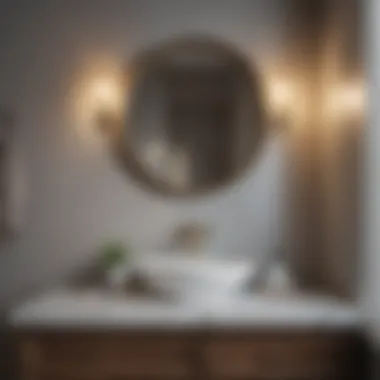

- Materials Composition: Depending on the mixture, some quartz countertops have a higher potential for recycling compared to others.
- Local Programs: Seek out local recycling programs that accept quartz or engineered stone to ensure proper disposal and recycling.
- Green Certifications: Check for products that have been certified under environmental standards, which can indicate their sustainability and recyclability.
Homemakers and owners aiming to make eco-friendly decisions can drive demand for quartz products that focus on lessening environmental impact. This will push manufacturers towards more sustainable and innovative practices, making quartz an appealing choice for those wishing to enhance both functionality and ecological responsibility in their bathroom spaces.
"The future will be green, or not at all." - Unknown
Understanding these elements helps consumers make informed choices. Selecting quartz countertops with awareness of their environmental impact reinforces the importance of sustainability in modern design.
Budgeting for Quartz Countertops
Budgeting for quartz countertops is a vital aspect of kitchen and bathroom renovations. The right financial plan can make a significant difference in the quality of materials used and the overall outcome of the project. The first step is to understand the key components of the budget, which include material costs, installation fees, and long-term investments related to maintenance and repairs. Knowing how much to allocate can help homeowners make informed decisions that align with their aesthetic goals and practical needs.
Cost Analysis: Material and Installation
When assessing the costs associated with quartz countertops, both material and installation expenses must be considered. The price of quartz slabs can vary, typically depending on the color patterns, veining, and brand. For example, common colors may cost between $50 to $75 per square foot, while more exotic colors can reach $100 or more per square foot.
In addition, installation costs must be factored into the budget. This can range anywhere from $30 to $100 per square foot based on the complexity of the project. It is crucial to get multiple quotes from skilled professionals to ensure competitive pricing.
Key cost components include:
- Material Costs: Pricing fluctuates based on various factors like color and pattern.
- Installation Fees: Rates vary by region and contractor experience.
- Additional Elements: Consider the costs for sinks, faucets, and any custom fabrication required.
With all these factors in mind, creating a budget that accommodates both material and installation costs will set a solid foundation for the project.
Long-Term Value and Investment
Choosing quartz countertops is not just a matter of immediate expenditure but a long-term investment. Their durability means they are less likely to chip or crack compared to other materials. As a result, they can last for decades with proper care. This quality creates significant value, as it reduces the likelihood of needing replacement or repairs over time.
From a resale perspective, homes featuring high-quality countertops often attract better offers. Buyers appreciate the timeless appeal of quartz, which can enhance the overall aesthetic of a bathroom.
Homeowners should also consider the low maintenance requirements of quartz countertops. The non-porous surface minimizes the risk of stains and bacteria, thus reducing long-term cleaning costs. By investing in quartz, homeowners may indeed find they save money in the long run.
"Investing in quartz countertops not only elevates the beauty of your bathroom but also adds long-term value to your home."
By comprehensively evaluating costs and considering the investment's lasting benefits, homeowners can budget effectively and achieve a balance between beauty and practicality in their spaces.
Maintaining and Caring for Quartz Countertops
Maintaining quartz countertops in bathroom vanities is crucial to ensure their beauty and functionality over time. While quartz is inherently durable, regular care is essential to avoid damage and preserve its appearance. Understanding how to properly maintain quartz surfaces can enhance their longevity and maintain the aesthetic appeal that they bring to your bathroom.
Cleaning Best Practices
Cleaning quartz countertops is straightforward, but the right techniques can make a significant difference in their upkeep. First, it is beneficial to use a mild dish soap mixed with warm water for routine cleaning. A soft cloth or sponge can effectively remove everyday dirt or spills without scratching the surface. Avoid abrasive cleaners, as they can dull the look of the quartz over time.
Here are a few practical cleaning tips:
- Wipe up spills promptly: This prevents stains from setting in.
- Use coasters or trays: Place these under items that can produce moisture or heat.
- Rinse and dry: After cleaning, rinse the countertop with clean water and dry it with a soft towel to prevent water spots.
"Regular maintenance leads to long-lasting beauty and durability in quartz countertops."
Avoiding Common Mistakes
Several common pitfalls can lead to damage or a decline in appearance of quartz countertops. Recognizing these can help maintain their integrity. One mistake is using harsh chemicals or acidic cleaners, which can compromise the seal and shine of the surface. Another is neglecting to use cutting boards when preparing food. Cutting directly on quartz can scratch the surface,
Here are some mistakes to avoid:
- Avoid extreme heat: Do not place hot pots directly on the surface; use trivets instead.
- Don’t use abrasive sponges: Stick to soft cloths to clean without scratching.
- Skip the bleach: Avoid full-strength bleach, as it can damage the resin used in quartz.
By applying proper cleaning techniques and avoiding damaging habits, homeowners can extend the life and luster of their quartz countertops in bathroom vanities, keeping the investment both beautiful and practical.
Ending
In this article, we have explored the multifaceted nature of quartz countertops in the context of bathroom vanities. A thorough understanding of quartz as a material reveals its unique composition and advantages, particularly in terms of durability, aesthetics, and ease of maintenance.
Final Thoughts on Quartz Countertops
Quartz countertops offer a sophisticated and practical solution for bathroom vanities. They combine beauty and functionality, making them an appealing choice for homeowners. Their resistance to stains and scratches means they can withstand the demands of daily use. Furthermore, quartz provides a vast range of design options, accommodating various styles from modern minimalism to classic elegance. This material's consistency in color and pattern leads to a uniform look, enhancing the overall visual appeal of any bathroom. The low maintenance requirements of quartz countertops allow for a stress-free experience, giving homeowners more time to enjoy their spaces.
"Investing in quartz countertops is not just a decision about style; it is about functionality and long-term value."
Encouragement for Informed Choices
As you consider quartz countertops for your bathroom, it is essential to educate yourself about the material's capabilities and limitations. Assess your specific needs and preferences. Consider the design elements that will complement your unique space. Speak with professionals, read customer reviews, and gather as much information as possible. Making an informed decision not only enhances the beauty of your home but also ensures that you get value for your investment. Engaging with a knowledgeable supplier can also provide insights into maintenance and care practices that will prolong the life of your countertops.
In summary, quartz countertops represent a wise investment in both functionality and aesthetics for bathroom vanities. With a deeper understanding and careful consideration, you can make choices that reflect your aspirations for a beautiful and practical home.

